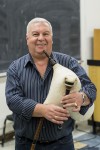Each week, Daily Bruin A&E will explore the instruments of the World Musical Instrument Collection and their performers that all contribute to the musical landscape of the UCLA Herb Alpert School of Music. This week, we highlight Bulgaria’s gaida, a sheep or goatskin bagpipe from the Balkans and Southeast Europe.
Ivan Varimezov could only listen to a single national radio station when he was growing up in 1970s Communist Bulgaria. The station played little other than Bulgarian folk music, and eventually, Varimezov was drawn to the sound of the genre’s most prominent instrument: the gaida, a traditional Bulgarian bagpipe.
At 7 years old, Varimezov taught himself to play basic gaida notes by ear while listening to the radio. When his uncle Kostadin, one of Bulgaria’s most famous gaida players, visited family in southeastern Bulgaria, he taught Varimezov how to read music and wrote simple melodies for him to practice.
“It was a very big, happy moment when I started to play,” said Varimezov, now an adjunct associate ethnomusicology professor. “I wanted to learn the instrument and continue (my uncle’s) way.”
Varimezov chose to attend a secondary school for folk music. There, students learned Bulgaria’s seven regional music styles primarily through demonstration because of the lack of recording technology and musical variety on the radio. Varimezov was further exposed to gaida music by attending live events like weddings and birthday celebrations.
“In the Bulgarian villages, they always invite bagpipers to play,” Varimezov said. “At that time, they didn’t have sound (systems), and (the) bagpipe is loud, so people would hear that somebody is having a wedding.”
Varimezov continued his folk music education at the conservatory in Plovdiv, Bulgaria where he obtained a degree in conducting and met his wife, Tzventanka Varimezova, who is also an adjunct associate ethnomusicology professor at UCLA. Every school year, the couple’s classes put on a collaborative folk music concert in the spring.
In his “Music and Dance of Balkans” class at UCLA, Varimezov teaches self-composed Bulgarian folk melodies to his student ensemble. Although a few students have asked him for gaida lessons, most play modern instruments like the clarinet and bass guitar.
Varimezov teaches freestyle music and allows his students to improvise – a bit like jazz, he said. However, he insists that students must master traditional Bulgarian melodies before they can get creative with their music.
Varimezov considers these folk melodies a gift he bestows upon his students’ futures as musicians.
“The most important thing is not to change so much the style,” Varimezov said. “Back then, the music was passed on orally. Now, they must know what the foundation of the music is. Otherwise, we lose the authenticity of the melody.”
Varimezov’s oldest daughter begged him for gaida lessons when she was a young girl. He made her a small bagpipe and taught her to play and, as an adult, she is now a talented musician, Varimezov said. His wife and younger daughter both play the tambura, a Balkan mandolin, and the four like to play as a band during family gatherings.
“The Bulgarians enjoy traditional music. We keep it alive,” Varimezov said. “Singing and playing (Bulgarian folk music) is like a national flag.”
Compiled by Gabriella Kamran, A&E contributor.

I appreciate these articles – but in a “Sounds of…” series, why is there no video or audio? If not of the featured artist, at least find a representative performance on youtube or soundcloud. Leverage the power of your online presence.